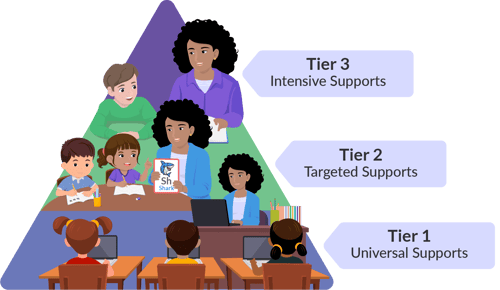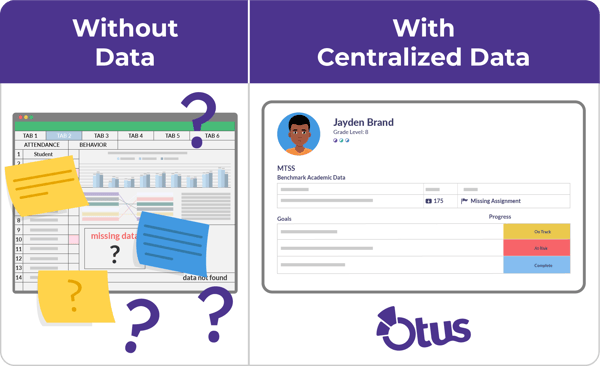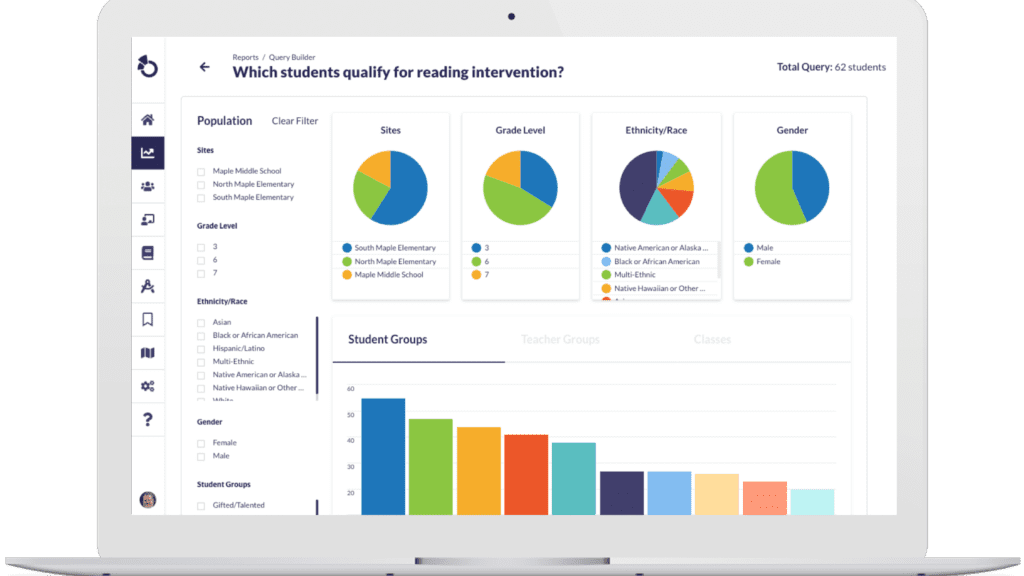How to Strengthen MTSS Interventions: What Works at Each Tier (2026)
By: Otus Team
Every classroom is home to students with different needs, strengths, and learning speeds. Some grasp new material almost instantly. Others need more time, repetition, or one-on-one guidance. Academic interventions are what help bridge those gaps so every student can grow.
Within a Multi-Tiered System of Supports (MTSS), academic interventions bring structure to that process. They help educators know when students need help, what kind of support to provide, and how to track progress to make sure it’s working.
And the key to making it all come together is data, teamwork, and consistency.
What are academic interventions?
Academic interventions are planned, evidence-based actions designed to help students strengthen specific skills. They aren’t homework or punishment. Instead, they’re intentional supports that build confidence and close learning gaps before they widen.
What academic interventions might look like
- Small-group instruction focused on reading comprehension
- Reteaching key math concepts during an intervention block
- One-on-one tutoring for students who need focused attention
- Scaffolded assignments that gradually build independence
Think of interventions as the “how” behind student growth. They ensure that every learner gets what they need to succeed.
How academic intervention fits within MTSS
MTSS organizes academic support into three tiers so educators can match the right level of help to each student.
Tier 1: Universal Instruction
This is the foundation of MTSS. It’s the instruction and support that every student receives every day. When Tier 1 is strong, most students thrive.
What it looks like in practice:
- High-quality, standards-aligned core instruction
- Differentiation and formative assessments
- Universal screeners to identify who might need more help
Tier 2: Targeted Support
This tier provides focused, small-group interventions for students who need extra support beyond the core (Tier 1). These sessions are short-term and based on specific skill gaps.
What it looks like in practice:
- Phonics or fluency groups for reading
- Math fact fluency sessions during designated support time (advisory periods)
- Weekly check-ins to review progress and set goals
Tier 3: Intensive Support
Tier 3 is for students who need highly individualized support. These interventions are often 1:1 and may involve specialists or outside services.
What it looks like in practice:
- Individualized reading instruction with a literacy specialist
- Intensive math tutoring based on diagnostic data
- Personalized intervention plans with frequent progress monitoring
MTSS in action: Success at Brooklet Elementary School
At Brooklet Elementary in Georgia, the MTSS team meets regularly to review progress data across reading and math. When trends show several students struggling in a particular skill area, such as comprehension, teachers create small groups (Tier 2) to deliver targeted interventions. Students track their own progress in graph form, celebrating growth each week. These short, data-informed cycles have made a lasting difference in engagement and achievement.
The role of data and progress monitoring
Progress monitoring is what turns interventions into results. By regularly collecting data from formative assessments, observations, and digital tools, educators can see what’s working and what needs to change.
Without progress data, interventions can feel like guesswork. With it, schools gain insight into whether strategies are effective, when to intensify support, and when a student is ready to return to core instruction.
To make this process meaningful, educators need a consistent way to capture, visualize, and share progress data across teams. Centralized reports and clear data protocols ensure everyone–from classroom teachers to interventionists–has the same up-to-date information when planning next steps. This transparency keeps interventions aligned and responsive, no matter the tier.
Academic intervention strategies that strengthen MTSS
Knowing which interventions to use is only half the equation. The real success comes from how schools plan, deliver, and evaluate those interventions.
Effective strategies include:
- Using data to target specific skills rather than reteaching full units
- Setting measurable goals so everyone understands what success looks like
- Providing timely feedback to keep students engaged and informed
- Collaborating as a team across grade levels and roles
- Reviewing progress frequently to adjust supports when needed
When these strategies are used consistently, interventions function as a cohesive, sustainable system of support rather than isolated efforts.
Examples of academic interventions that work
Reading
|
Math
|
Writing
|
Each of these examples can fit within any MTSS tier; it all depends on how often and how intensively the support is provided.
Making academic interventions work in your district
Academic interventions are most effective when teams have the right data, tools, and communication systems in place. Otus brings these elements together by unifying assessment results, progress monitoring, and intervention data in a single tool.
Educators can identify which students need help, design interventions aligned to unique district goals, and easily track and measure their impact over time.
Turning support into growth
Thoughtful academic interventions create space for students to gain confidence, take ownership of their progress, and see that growth is always within reach, and that’s beautiful. With a clear MTSS framework and the right data tools, schools can ensure every learner gets the help they need right when they need it most.
Related Resources
Request a demo!
See exactly how Otus can help your school accelerate student growth and improve student outcomes – all while saving educators time.





